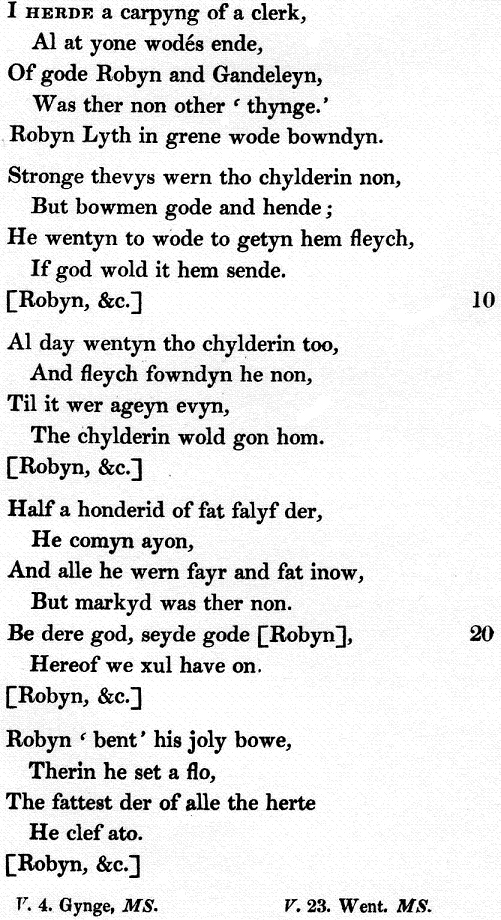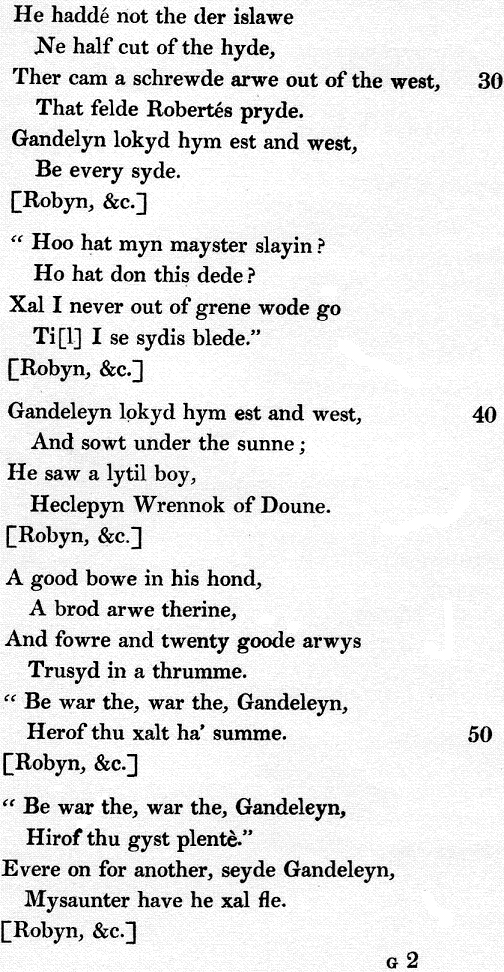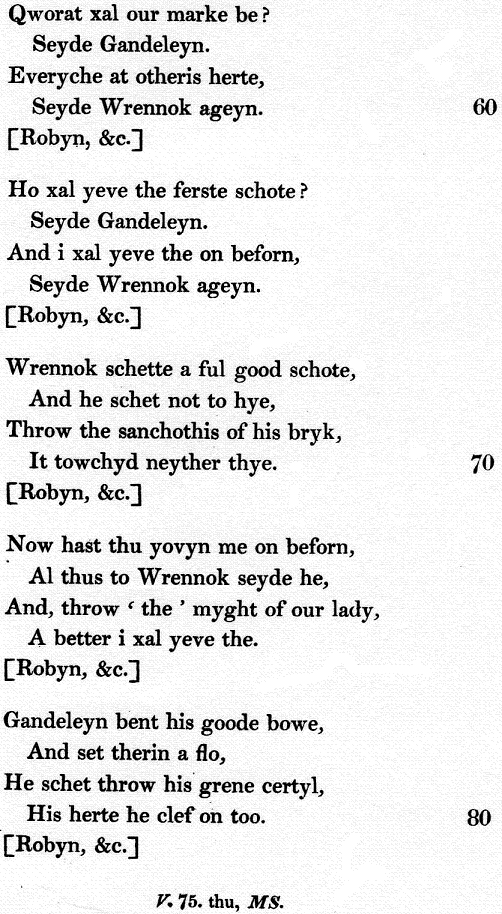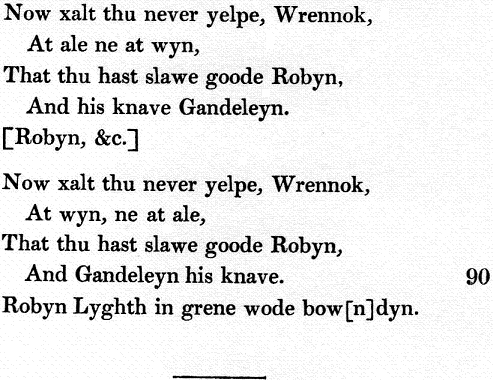Robyn and Gandeleyn
This medieval poems has been subject to varied and implausible interpretations. It was first published by Joseph Ritson in 1790, and has been reprinted many times since. Ritson (Ancient Songs and Ballads, revised ed.1829, p 81) gave it the title of ‘The Death of Robin Lyth’ as he thought that the Robin in this poem was none other than Robin Lyth, a native or inhabitant of Yorkshire, he gives two reasons: ‘the first is, that a few miles north of Whitby is a village called Lythe, whence he may be reasonably supposed to have acquired his surname: the second, that near Falmborough, in Holderness, is a large cavern in the rocks, subject, at present, to the influx of the sea, which, among the country people, retains to this day the name of Robin Lyth Hole; from the circumstance, no doubt, of its having been one of his skulking places’. Robert Graves (English and Scottish Ballads, 1957, pp. 149-50) thought that: ‘Although this seems to be a ballad about Robin Hood the Archer, its real subject is the New Year’s hunting of the wren in vengeance of the robin murdered at midsummer’. F. J. Child (Vol. III, pp.12-13) on the other hand, pointed out that in regards to Robyn and Gandeleyn, ‘thought is free’, he also mentions Thomas Wright (Songs and Carols) who remarks on the similarity of the name Gandelyn to Gamelyn in the tale assigned to the Cook in some manuscripts of the Canterbury Tales, and on the resemblance of the tale of Gamelyn to the Robin Hood story. Walter Skeat (Oxford, 1893, p. ix) believed that the Robyn of this poem was Robin Hood, and that Gandeleyn is a mere corruption of Gamelyn from the Tale of Gamelyn. It is interesting to note that Gandeleyn calls Robyn ‘myn mayster’, in stanza seven of Robyn and Gandeleyn,whereas Gamelyn encounters the ‘mayster outlawe’ in line 637 of the Tale of Gamelyn. Although Dobson and Taylor (Rymes of Robyn Hood, 1976, p. 256) have clearly expressed that ‘by no stretch of the imagination can the ‘Robyn’ of this lyric be properly identified with the Robin Hood of the other ballads’, it cannot be ruled out.
The poem occurs in a volume of poetical pieces, nearly all written in the same hand of about 1450. The manuscript contains seventy- four different lyrics, and has been attributed (not certainly) to the abbey of Bury St Edmunds by R. L. Greene in his edition of A Selection of English Carols (Oxford, 1962), p. 173. It appears that the manuscript had been copied hastily and inaccurately by its scribe, and it should be remembered that the manuscript text is written continuously, with irregular use of punctuation marks to signal the close of the poetic line. I have used the edition by Ritson, which has been divided into stanzas.
The tale opens with Robyn and Gandeleyn going to the woods to hunt deer. They search all day but can find no ‘fleych’. When evening approaches they are about to go home, when suddenly they come upon half a hundred fat fallow deer. Robyn bends his ‘joly bowe’ and shoots the fattest deer of all, he then proceeds to remove the hide, but before he can finish, he is slain by an arrow. Gandeleyn looks east and west and by every side in an effort to find the assailant, and he vows not to leave the greenwood ‘Til I se sydis blede’. Again Gandeleyn looks east and west but this time he sees Wrennok of Donne, armed with bow and arrows. They confront each other and words are exchanged. Wrennok has the first shot, it passes harmlessly through Gandeleyn’s legs, then he in reply shoots Wrennok through the heart.
Source: British Library, Sloane MS. 2593, fos. 14v-15v.
Editions: Joseph Ritson, Ancient Songs and Ballads (London, 1790), p. 48, revised edition (London, 1829), p. 82-85; Thomas Wright, Songs and Carols printed from a Manuscript in the Sloane Collection in the British Museum (London, 1836), No. X; Gutch, 1847, II, 36-8; Child, 1888, III, 13-14; Quiller-Couch, 1910, pp. 462-5; Leach, 1955, pp. 332-4; Oxford Book of Ballads (1969), pp. 374-7; Oxford Book of Medieval English Verse (1970), pp. 437-40; Dobson and Taylor, Rymes of Robyn Hood, 1976, pp. 256-257.
Robyn and Gandeleyn / The Death of Robin Lyth (Ritson)

|



